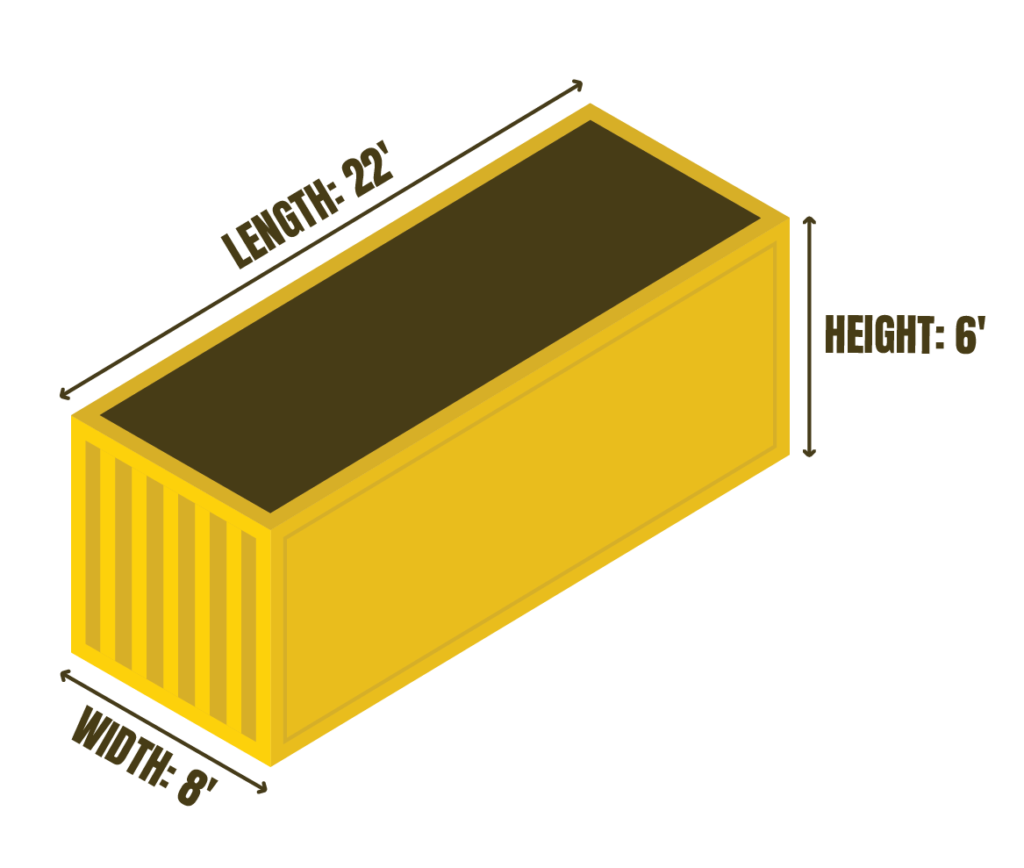If you’re planning a major renovation, large demolition, or a commercial-sized cleanout in Winnipeg, a 40-yard dumpster rental is often the simplest way to manage waste on site. This guide walks you through what a 40-yard dumpster is, how big it really is, where it works best, Winnipeg permit rules you should know, weight and loading best practices, and when to call Mr. Garbage so the job gets done safely and without surprise headaches.
What is a 40-yard dumpster rental? (quick definition)
A 40-yard dumpster rental is a large roll-off container with tall side walls designed to hold a lot of bulky debris. It’s commonly used for large construction projects, full-house demolitions, or big property cleanouts. When people ask “how big is a 40-yard dumpster,” they mean volume and practical capacity, not just the footprint on your driveway. For quick orientation: a 40 cubic yard container is a high-walled, heavy-duty bin built for large volumes of loose and bulky material.
Dimensions and capacity: How big is a 40-yard dumpster?
Understanding the physical size helps you plan placement and access.
- Volume: 40 cubic yards (this is the container’s rated capacity).
- Typical footprint and height: these bins are long, wide, and tall; a common 40-yard roll-off has a footprint similar to a standard vehicle lane and taller walls than smaller bins.
- Exact external dimensions vary by manufacturer and truck type, so confirm with your hauler before delivery. dumpsters.com
Why these numbers matter: the height gives the 40-yard bin the extra cubic yardage, while the footprint affects whether it will fit entirely on your driveway or require street placement.
Who uses a 40-yard dumpster rental?
A 40-yard dumpster is suited to projects that generate a large volume of material:
- Major home demolitions and whole-house gut renovations.
- Large construction projects and multi-unit units where framing, drywall, roofing, or siding waste accumulates.
- Commercial cleanouts, large landscape work, and property redevelopment pushes.
If your project fills a smaller size quickly or you have lots of very heavy materials, a different size or multiple bins might work better. Mr. Garbage can help match your project to the right solution.
Weight limits and material types: what you can (and can’t) overload
Volume isn’t the only constraint; weight matters. Each 40-yard dumpster has a maximum transport weight based on local road rules and carrier limits.
A 40-yard container can hold many cubic yards of light material (like insulation or boxed household junk) and significantly less if you’re loading dense materials (concrete, brick, soil). Overweight loads create safety hazards and can be refused at the transfer station.
Local haulers and municipalities often apply weight limits and will classify materials. Planning by material type prevents overage issues.
How long is a 40-yard dumpster, and how tall is it?
When planning placement, ask the supplier for exact external dimensions. The general expectation is that a 40-yard roll-off is long enough to require a sizable driveway or street space and tall enough that loading bulky items is easier without multiple breakdowns.
Because variations exist between manufacturers, always confirm dimensions and truck access with your provider before booking. Mr. Garbage will confirm dimensions and street placement rules when scheduling a delivery. Mr. Garbage
Winnipeg rules: permits, placement, and public right-of-way
If your 40-yard dumpster will sit completely on private property (a driveway or private parking pad), most of the time you won’t need a city permit. But if any portion of the container will sit on public property, street, sidewalk, or boulevard, Winnipeg requires permits and compliance with rules designed to protect traffic and pedestrians. That includes obtaining a streetside permit and following placement restrictions. Always confirm placement rules before delivery to avoid fines or forced relocation. City of Winnipeg
Mr. Garbage routinely handles permit coordination for streetside placements to keep your project moving without municipal hassles. Mr. Garbage
Choosing the right 40-yard dumpster: practical considerations.
Project volume vs material density
Think volume (how much space the rubbish occupies) and density (how heavy it is). A 40-yard bin is great when volume is the driver, large cardboard, drywall, wood framing, but less efficient if you need to dispose of heavy masonry or soil without checking weight limits. dumpsters.com
Site access and truck turning radius
These bins require a roll-off truck to deliver and pick up. Ensure clear access, overhead clearance (no low power lines or tree limbs), and stable ground. If the truck can’t get close enough, the team may need to place the bin further from your work area or coordinate an alternate solution.
Neighbourhood and condominium rules
If you live in a homeowners’ association, condo complex, or rental community, check the property rules. Even if the city grants permission, your strata or landlord may have restrictions.
Loading best practices: how to load a 40-yard dumpster safely and efficiently
- Load evenly. Keep the material level across the container to allow safe transport.
- Break down large items where practical. Flatten boxes and disassemble furniture where feasible.
- Place heavy items low and near the center of the bin. This helps with truck weight distribution.
- Don’t block the truck’s access points with piled material; leave clear loading space.
- Avoid placing hazardous materials in the same bin unless your hauler accepts them; some items need special handling.
Following loading rules reduces the risk of rejected loads, extra handling fees, or safety incidents.
Environmental and operational context for Winnipeg projects
Waste diversion is a national and local priority. Canada’s most recent national data show that a certain portion of solid waste is diverted from disposal, an indicator that better sorting and site planning help reach diversion goals. Using roll-off services that separate recyclable or reusable materials helps reduce landfill contributions from construction and demolition activities. Choosing a hauler who prioritizes diversion is part of responsible project planning. Canada
Mr. Garbage works with local transfer stations and recycling partners to divert suitable materials, reducing what goes to landfill while making compliance easier for you. Mr. Garbage
Real-world example: a Winnipeg renovation that needed a 40-yard dumpster
Scenario: A homeowner does a full kitchen and two-room second-floor remodel that creates a mix of drywall, cabinetry, flooring scraps, and old appliances.
- Why a 40-yard dumpster made sense: the project produced large, awkward materials and a steady flow of waste for a protracted period. The taller walls and larger volume prevented multiple small bin swaps.
- Permits and placement: the team placed the bin on a long private driveway; no city permit required. For a street placement, an approved permit would have been obtained.
- Diversion step: salvageable cabinetry and metal were separated and routed to recyclers.
This setup reduced truck trips and simplified daily cleanup for the crew.
When NOT to choose a 40-yard dumpster
- If your project is a single-room refresh or small garage cleanout, a smaller bin is usually more economical and easier to place.
- If your debris is extremely heavy (lots of concrete, brick, or dirt), a smaller bin with higher weight tolerance or multiple smaller hauls may be safer.
- If you lack sufficient access for a roll-off truck (narrow lanes, overhead obstructions), consider alternatives like a commercial pick-up or multiple smaller trailers.
Mr. Garbage can evaluate your site and recommend whether a 40-yard dumpster is the right fit or propose alternatives.
Logistics: delivery, pickup, and timing
Delivery and pickup require a truck with space to maneuver. Your hauler will plan a delivery window and will generally ask you to:
- Confirm placement and clear the area of obstacles.
- Ensure legal permission for any street placement.
- Confirm project timeline so pickup aligns with project stages.
If an earlier pickup or emergency removal is needed, most haulers provide expedited pickup options; discuss availability when you schedule.
Safety and neighbourhood etiquette
- Keep the bin within your property line or permitted zone.
- Don’t overload to the point that items stick over the top or block sidewalks.
- Secure loose materials in windy weather—tarps or netting help.
- Communicate with neighbours about timing and placement to avoid surprises.
Being proactive avoids complaints, fines, and delays.
Why homeowners in Winnipeg choose Mr. Garbage for 40-yard dumpster rental
- Local experience: Mr. Garbage operates in Winnipeg and knows city permit rules and typical site challenges.
- Full-service coordination: we can handle permit paperwork for streetside placements and make sure bins meet local rules.
- Diversion-first approach: we work with local partners to route recyclable and salvageable materials away from landfill when possible.
If you prefer a hands-off solution, single contact, single scheduling call, responsible disposal, a professional hauler keeps the project running while you focus on the build.
Conclusion
If your project produces large volumes of waste, bulky construction debris, or a mix of materials over several days, a 40-yard dumpster rental is often the right tool. It lowers daily hassle, reduces truck traffic, and keeps your site cleaner and safer.
Before you book, confirm access, check whether any part of the bin will sit on a public right-of-way (so you can arrange permits), and plan for material separation if diversion matters to you.
When the project is big or you’d rather not juggle permits and multiple drop-offs, Mr. Garbage can deliver the bin, handle required permits, and coordinate drop-offs to keep the job compliant and tidy. Book Mr. Garbage for your 40-yard dumpster rental and get your project moving with fewer headaches.
Frequently Asked Questions (FAQs)
What is a 40-yard dumpster rental?
A 40-yard dumpster rental is a large roll-off container with a rated capacity of forty cubic yards, intended for high-volume projects like major renovations, demolition, or large commercial cleanouts.
Do I need a permit to place a 40-yard dumpster on the street in Winnipeg?
If any part of the dumpster will sit on public property — including a street, sidewalk, or boulevard- Winnipeg requires permits, and placement rules must be followed. If the container sits fully on private property, a permit is usually not required. Check with the city or have your hauler manage the permit.
How much weight can a 40-yard dumpster hold?
Weight limits vary by hauler and local transport regulations. While the container can hold a large volume of material, heavy materials like concrete and soil may reach weight limits long before the space is full. Always confirm weight allowances with your provider.
Will a 40-yard dumpster fit on my driveway?
Many driveways can accommodate a 40-yard dumpster, but this depends on driveway length, overhead clearance, and truck access. Confirm dimensions and site access with your hauler before scheduling delivery.
When should I call a professional hauler like Mr. Garbage for a 40-yard dumpster?
Call a professional when your project produces large volumes, includes a mix of material types, requires street placement and permits, or if you prefer a single point of coordination for delivery, sorting, and responsible disposal.

